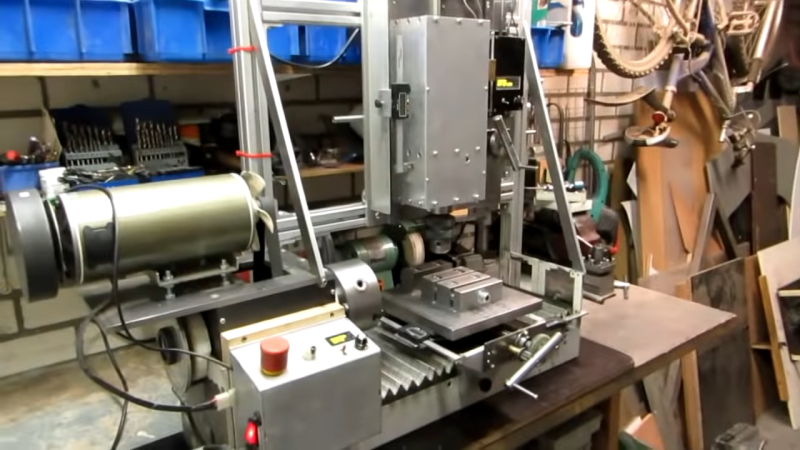One thing’s for sure: after seeing [Roland Van Roy] build a vertical mill from industrial scrap, we’ve got to find a better quality industrial scrapyard to hang around.
The story of this build started, as many good shop stories do, at the lathe, which in this case was also a scrapyard build that we somehow managed to miss when it first posted. This lathe is decidedly different from the common “Gingery method” we’ve seen a few times, which relies on aluminum castings. Instead, [Roland] built his machine from plate stock, linear slides, and various cast-off bits of industrial machines.
To make his lathe yet more useful, [Roland] undertook this build, which consists of a gantry mounted over the bed of the lathe. The carriage translates left and right along the bed while the spindle, whose axis lines up perfectly with the center axis of the lathe, moves up and down. [Roland] added a platform and a clever vise to the lathe carriage; the lathe tool post and the tailstock are removed to make room for these mods, but can be added back quickly when needed. Digital calipers stand in for digital read-outs (DROs), with custom software running on a Picaxe and a homebrew controller taking care of spindle speed control.
[Roland] reports that the machine, weighing in at about 100 kg, exhibits a fair amount of vibration, which limits him to lighter cuts and softer materials. But it’s still an impressive build, and what really grabbed us was the wealth of tips and tricks we picked up. [Roland] used a ton of interesting methods to make sure everything stayed neat and square, such as the special jig he built for drilling holes in the T-slot extrusions to the use of cyanoacrylate glue for temporary fixturing.















de tering
That PCB making technique was fantastic blast from the past with Leo feel ;)
Very impressive build.
indeed very impressive. some serious skills displayed.
Complimenten Roland, jij weet wat je doet !
What a legend. It’s good to see this sort of content.
Earlier this year I fabricated a small milling machine from scrap:
http://levysounddesign.blogspot.com/2020/06/homemade-milling-machine.html
Recently I finished a DRO for my mini lathe using cheap digital calipers:
http://levysounddesign.blogspot.com/2021/01/digital-readout-dro-for-mini-lathe.html
* early last year… Time flies
Very cool and quite impressive. It makes me want to finish my own Mini Mill DRO project!
If those projects haven’t been featured on Hackaday, they certainly should be.
That’s a nice build, and a very nice writeup on the DRO. Good work!
Resourceful design for lighter materials… though the stickiness of some softer materials makes me cringe.
Great seeing some steel or at least iron in the comment threads.
I worry about some of the designs being aluminum extrusion when decent machine cast salvage can be found reasonably priced that can have the voids filled in too once cutting and fabrication is done if needed/wanted.
There are the concrete and granite resin methods too Hackaday’s demonstrated.
https://hackaday.com/?s=epoxy+granite
https://hackaday.com/?s=concrete+granite
https://hackaday.com/?s=concrete+mill+lathe
Thinking the cast iron/steel blocks or even I guess large enough heads can be waterjet cut, ground or even machined, drilled and tapped, and used for a stiffer more solid design.
I’m well away of space and size concerns and wonder at times why I’ve turned down way cost effective and even free CMM/CMS granite surface plates. Understandable. Just received a few days ago, a reported 0.001″ spec straight edge that I still need to verify since I DON’T have a 24″ surface plate or another to compared to. My largest surface plate is 18″ since man, I have the room and that’s just before where the shipping spike goes significantly more.
Might be a little pricey for many, though I just picked up a plate from a autonomous robot LiDAR system and they have more left. I almost invested in a second for a welding table. I haven’t cleaned off yet to determine how true. Way better price than I can find anywhere left.
https://www.ebay.com/itm/27-1-2-x-39-1-4-Plate-Steel-3-4-Thick-Layout-Setup-Workholding-Jig/363032368202
They have a nice size angle plate I’ve been looking at too.
If the milling head could be coupled to the axial (L/R) movement of the carriage, the lathe could do thread-milling.
awesome work
Very nice work!
For another take on “machine tools from scrap” check out the Multimachine! I love the factt that the multimachine relies on the already-high-precision cylinder bores for sliding elements and high-tolerance parallelism.
http://opensourcemachine.org/wp-content/uploads/2008/10/how_to_build_a_multimachine1.pdf